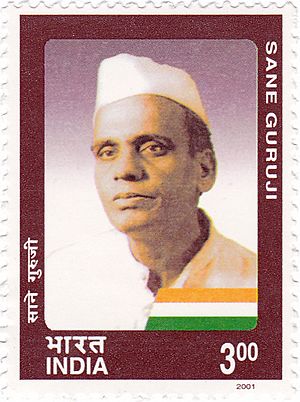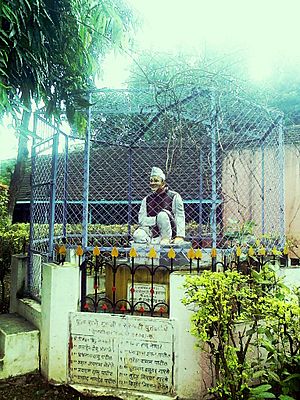Pandurang Sadashiv Sane facts for kids
Quick facts for kids
Pandurang Sadashiv Sane
|
|
|---|---|
 |
|
| Born | Pandurang Sadashiv Sane 24 December 1899 Palgad, Bombay State, British India (present-day Ratnagiri, Maharashtra, India) |
| Died | 11 June 1950 (aged 50 years) |
| Occupation | Writer, teacher, social activist, freedom fighter |
| Nationality | Indian |
| Notable works | Shyamchi Aai |
Pandurang Sadashiv Sane (born December 24, 1899, died June 11, 1950) was a very important person from Maharashtra, India. People often called him Sane Guruji, which means "respected teacher." He was a talented writer, a dedicated teacher, and a strong voice for social change. He also fought bravely for India's freedom from British rule. Many people remember him as the National Teacher of India.
Contents
Sane Guruji's Early Life
Sane Guruji was born on December 24, 1899, in a village called Palgad, near Dapoli in British India. This area is now part of the Ratnagiri district in Maharashtra state. His parents were Sadashivrao and Yashodabai Sane. He was their third child.
His father worked as a revenue collector, which meant he collected taxes from farmers for the government. For a while, Sane's family was quite well-off. However, their financial situation became difficult later on. Sadly, their house was taken by the government. Sane's mother, Yashodabai, passed away in 1917. This sad event, and not being able to be with her when she died, stayed with Sane Guruji throughout his life.
His Journey Through Education

Sane Guruji started his schooling in the village of Dondaicha. After that, he went to Pune to live with his uncle and continue his studies. But he didn't like it there and soon returned to Palgad. He then joined a missionary school in Dapoli, which was about six miles from his home.
At Dapoli, Sane quickly showed he was a very smart student. He was especially good at Marathi and Sanskrit. He also loved writing poetry.
As his family's money problems got worse, Sane found it hard to pay for school. He thought about getting a job to help his family. But a friend suggested he join the Aundh Institution, which offered free education and food to students who couldn't afford it. He faced many challenges there, but he kept studying hard. However, an outbreak of bubonic plague forced all the students to go home.
Back in Palgad, Sane overheard his father worrying about his dedication to studies. Feeling hurt, he immediately went back to Pune. He enrolled at the Nutan Marathi Vidyalaya. Life in Pune was still tough, and he often had very little to eat. Despite this, he continued to do very well in his studies. He earned his high school certificate in 1918. After high school, he went to New Poona College (now Sir Parshurambhau College). He earned his Bachelor's and Master's degrees in Marathi and Sanskrit literature.
Becoming a Teacher and Activist
Sane Guruji chose to become a teacher after finishing his studies. He taught at Pratap High School in Amalner. He preferred to teach in rural schools, even though he could have earned more money teaching wealthier students. He also worked as a hostel warden, looking after students.
Sane was an amazing speaker. He could captivate audiences with his passionate speeches about fairness and rights. While teaching, he started a magazine called Vidyarthi (meaning "student"). This magazine became very popular among students. He taught them important moral values, and they admired him greatly. He taught for only six years. After that, he decided to dedicate his life to fighting for India's freedom.
Fighting for India's Freedom
Sane Guruji left his teaching job in 1930 to join the Indian independence movement. This was when Mahatma Gandhi started the famous Salt March. Sane was arrested by the British authorities and spent more than 15 months in Dhule Jail for his part in the Civil Disobedience Movement.
In 1932, Vinoba Bhave, another important leader, was in the same jail as Sane. Bhave gave talks about the Bhagavad Gita every Sunday. Sane Guruji took notes during these talks, and these notes later became Bhave's famous book, Gītā Pravachane.
Between 1930 and 1947, Sane Guruji took part in many protests. He was arrested eight times and spent a total of six years and seven months in different jails across India. He also went on hunger strikes seven times.
While in Trichinapally Jail, he learned Tamil and Bengali. He even translated an ancient Tamil book called the Kural into Marathi. He believed it was important for Indians to learn each other's languages to bring the country together. He started a movement called Antar Bharati (meaning "Inner India") to promote this idea.
Sane Guruji helped spread the Indian National Congress's message in rural Maharashtra. He was also involved in organizing big meetings for the Congress party. He took part in election campaigns in 1936 and the Quit India Movement in 1942, for which he was again imprisoned. During this time, he worked closely with other socialist leaders.
Working for Social Justice
In the late 1930s, Sane Guruji also worked with factory workers and farmers in the East Khandesh District. He helped them organize and fight for their rights. He was connected with some communist leaders for a while. However, when the communists supported the Second World War, he disagreed with them and left their group. After India became independent, he joined the Socialist party.
Sane Guruji was a strong critic of groups that promoted Hindu nationalism. He believed in equality for everyone.
Ending Caste Discrimination
Sane Guruji was deeply committed to ending untouchability, a harmful practice where some people were treated as "untouchable" because of their birth. He was inspired by Mahatma Gandhi's promise to fight against this discrimination.
To raise awareness, Sane Guruji traveled all over Maharashtra for about four months in 1947. His efforts led to a major event: he went on a fast at Pandharpur. His goal was to open the famous Vitthal Temple to people who were considered "untouchables." His fast lasted for 11 days, from May 1 to May 11, 1947. Because of his dedication, the doors of the Vitthal temple were finally opened to everyone.
His Final Years
After India gained independence, Sane Guruji became sad that inequality still existed in Indian society. The assassination of Mahatma Gandhi deeply affected him. In response, he went on a fast for 21 days. Sane Guruji was very upset by various issues in the newly independent country. He passed away on June 11, 1950.
His Lasting Legacy
Sane Guruji left behind a powerful legacy that continues to inspire people today:
- Antar Bharati: This organization, founded by Sane Guruji, still works to achieve his dream of a united India. It runs programs for children and young people, including family exchanges and national integration camps. The organization also publishes a monthly Hindi magazine called "Antar Bharati."
- Pandharpur Temple Commemoration: Every year on May 10, Sane Guruji's followers gather to remember the day the Pandharpur temple was opened to the Dalit community.
- Sadhana Magazine: Sane Guruji started a Marathi magazine called Sadhana for intellectual discussions. It is still published today from Pune and is widely read by Marathi speakers.
- National Memorial: In 1999, to celebrate 100 years since his birth, the Sane Guruji Rashtriya Smarak Samiti built a national memorial in his name. It is located in Vadghar, Raigad district, Maharashtra. This memorial has a camping site, guest rooms, a library, and a place for translating his works into different Indian languages. It has been used as a camping ground for students since 2001.
- Commemorative Stamp: The Indian Postal service honored him by issuing a special postage stamp in 2001.
His Literary Works
Sane Guruji wrote around 135 books, and about 73 of them have been published. Almost all of these books are considered literature for children. His most famous work in Marathi literature is Śyāmacī Āi (Shyam's Mother). This book has been translated into almost all Indian languages, as well as Japanese and English. Other notable works include Bhāratiya Saṃskṛti (Indian Culture) and Patri, which is a collection of songs and poems.
One of his books, "Teen Muley" (Three Children), is a heartwarming story about three children. It is considered a classic and one of the best books written in Marathi.
He also started a weekly journal called Sadhana (weekly) on August 15, 1948. This journal has been published regularly ever since.
Images for kids


